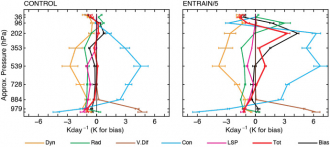| ← prev Stochastic parametrisations in weather and climate |
Contents |
next → On the response of Euro-Atlantic regimes to forcing and the Palmer Hypothesis |

Mark Rodwell
ECMWF
The cover figure of the edition of the Bulletin of the American Meteorological Society containing Tim’s seamless prediction paper (Palmer et al., 2008) shows a chain joining anthropogenic emissions to climate change. The links of the chain divide the key processes involved into their respective timescales. The links represent ‘fast physics’, global teleconnections, and interactions with the oceans, cryosphere and biosphere. The abilities of climate models to correctly represent responses to anthropogenic emissions, Palmer et al (2008) argued, being only as good as the weakest link in the chain. There is a need, therefore, to evaluate and improve the same model for each link within the chain – a seamless approach.
Early in my career at ECMWF, Tim pointed me to a paper by Klinker and Sardeshmukh (1992). Their approach was to learn about systematic model error from process tendencies during the very first timestep, averaged over a series of forecasts. This approach has a lot of potential because, at such a short leadtime, it represents a ‘local’ evaluation of the model’s ‘fast physics’ at our best estimate of the true state of the atmosphere, before interactions and feedbacks with the global circulation have had time to contaminate the diagnosis. As such, it represents an assessment of the strength of Tim’s first chain link.
In the years since Klinker and Sardeshmukh (1992), 4 dimensional variational data assimilation had been introduced at ECMWF (4DVar; Rabier et al, 2000) and it was speculated that the analysed state would be so much closer to the model’s attractor that the mean forecast tendency over the first timestep would be virtually zero, and thus uninformative of the model’s fast physics error. Nevertheless, Tim suggested to me that it might be good to check if the approach could be developed. To make the diagnosis more precise, we needed to account for the diurnal cycle, and so took a mean of the 0-6 h tendencies every 6 h analysis cycle.
There was a nice application to test our re-vamped approach. The influential “climateprediction. net” project (Allen, 1999) had allowed the Hadley Centre’s climate model (initially the version with a slab ocean, HadSM3) to be run on thousands of home computers with perturbations to uncertain parameters. Results suggested that climate sensitivity to a doubling of carbon dioxide could be anywhere between about 2 and 12K (Stainforth et al., 2005). With the help of David Stainforth, we ascertained that one particular perturbation was involved with all climate sensitivities above 6K. This perturbation was a 5-fold reduction in the entrainment rate (ENTRAIN/5) – controlling the mixing between convective plumes and their environment. This parameter perturbation was an ideal candidate to test our ‘initial tendency’ approach within the ECMWF model (version 29r1). A key focus was the Amazon region during January, when latent heating from convection is an important component of the temperature budget.
The figure, from results in Rodwell and Palmer (2007), shows averaged vertical profiles of initial temperature tendencies from the dynamics and physical parametrizations in the model. The left panel shows the profiles for the control (unperturbed) model. We see how the convective heating (blue curve) is partly a response to the radiative destabilisation of the column (green) and partly balanced by the dynamical cooling of the ascending air (orange) associated with the large-scale monsoonal circulation. There is also evaporative cooling by the cloud scheme (pink). Summing over all the tendencies (red) we see that the temperature profile is quite well balanced – something we would hope to see with a good representation of the physics. The right panel shows the profiles for the model that had the ENTRAIN/5 perturbation in the data assimilation and the forecast. The initial convective heating (blue) is much stronger because the convective plumes detrain less buoyancy.

The dynamics, on the other hand, are fairly well constrained by observations of the large-scale circulation and respond more slowly to the latent heat forcing. The result is a strong total tendency imbalance (red), which indicates that the perturbed physics are unrealistic. We argued that, if the same result held for the HadSM3 model, then Stainforth et al’s maximum climate sensitivity could be halved.
The initial tendency approach has been tested in other ways, including its ability to identify an imposed physics error (Klocke and Rodwell, 2014) and to understand the impact of Saharan aerosol changes (Rodwell and Jung, 2008). Williams et al. (2020) have recently demonstrated the benefits of using NWP to validate the fast physics of the UK Met Office’s CMIP6 climate model.
With the advent of the Ensemble of Data Assimilations (EDA) at ECMWF, my work now includes initial uncertainty growth (Rodwell et al. 2016). A lack of ensemble variance is seen in situations prone to meso-scale convection (Rodwell et al. 2018) and too much variance growth is associated with cyclogenesis (Rodwell and Wernli, 2022). A reduction of the latter through reduced singular vector initial perturbations would produce a more seamless forecast system, enabling better estimation of model uncertainty in convective situations.
Tim has been a guiding influence throughout the course of my work at ECMWF, and I thank him and wish him well in his retirement.
| ← prev Stochastic parametrisations in weather and climate |
↑ top | next → On the response of Euro-Atlantic regimes to forcing and the Palmer Hypothesis |
